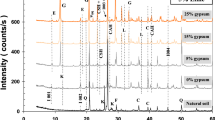Abstract
The bond which develops during curing between soil particles in the presence of lime and moisture is a result of the growth and the development of a newly formed cementitious phase (or phases). For the particular soil studied, appreciable reaction occurs between soil particles and lime only at elevated temperature, in a moist environment The growth and development of the new phase is accompanied by an increase in compressive strength of the soil-lime composites. Scanning electron microscopy (SEM) studies show the phase to consist of an interlocking network of fine platelets and fibres, and although no direct determination of composition was possible, evidence from X-ray analysis and thermal analysis shows that the new phase is poorly crystalline and probably consists of a hydrate of calcium silicate or calcium aluminate.
Similar content being viewed by others
References
J. L. Eades andR. E. Grim,Highway Research Board Bulletin 262 (1960).
R. L. Sloan, “Early reaction in the Kaolinite-hydrated lime-water system”, in Proceedings of the 6th International Conference on Soil Mechanics and Foundation Engineering, Montreal, Vol. 1 (1965) pp. 121–5.
S. Diamond, J. L. White andW. L. Dolch, “Transformation of Clay Minerals by Calcium Hydroxide Attack”, Proceedings, 12th National Conference on Clays and Clay Minerals edited by W. F. Bradley (Pergamon Press, New York, 1964) pp. 359–79.
J. B. Croft, “The processes involved in the hmestabilization of clay soils”, Proceedings, Australian Road Research Board, Sydney, Vol. 2, part 2 (1964) pp. 1169–200.
A. Le Rouse, “Traitements des sols argileux par la chaux”, Bull. Liaison Laho, Routiers P. et Ch. No. 40 (1969) pp. 59–96.
J. W. Vail andJ. D. Wet,J. Amer. Ceram. Soc.,55 (1972) 432.
G. Lees, M. D. Abdelkader, andS. K. Hamdani,J. Inst. Highways and Transportation 30 (12) (1983) 8.
J. Jambor,Mag. Concr. Res. 15 (45) (1963) 131.
Transportation and Road Research Board, “State of the art; Lime stabilization”, Transportation Reseach Circular, No. 180 (1976) pp. 1–31.
R. C. Mackenzie, “Differential Thermal Analysis”, Vol. 1 (Academic Press, London, 1970) pp. 517, and 592.
R. E. Grim, “Applied Clay Mineralogy” (McGraw Hill, New York, 1960) p. 102.
H. Beutelspacher andH. W. Vander Marcel, “Atlas of electron microscopy of clay minerals and their admixtures” (Elsevier, Amsterdam, 1967) pp. 117–18, 127-9.
R. N. Yong andB. P. Warkentin, “Soil properties and behavour” (Elsevier, Amsterdam, 1975) p. 81.
F. M. Lea, “The Chemistry of Cement and Concrete” (Edward Arnold, London, 1976) p. 207.
H. F. W. Taylor, “Studies on the Chemistry and Microstructure of Cement Pastes”, Proceedings of the Conference on Chemistry and Chemically Related Properties of Cement, Imperial College, April 1984 (The British Ceramic Society, London, 1984) pp. 65–82.
S. Diamond, “Cement Paste Microstructure”, Proceedings of the Conference on Hydraulic Cement Pastes-Their Structure and Properties, Sheffield, 1976 (Cement and Concrete Association, Slough, 1976) p. 2.
B. J. Dalgleish andP. L. Pratt,J. Mater. Sci. 17 (1982) 2199.
Author information
Authors and Affiliations
Rights and permissions
About this article
Cite this article
Arabi, M., Wild, S. Microstructural development in cured soil-lime composites. J Mater Sci 21, 497–503 (1986). https://doi.org/10.1007/BF01145514
Received:
Accepted:
Issue Date:
DOI: https://doi.org/10.1007/BF01145514




